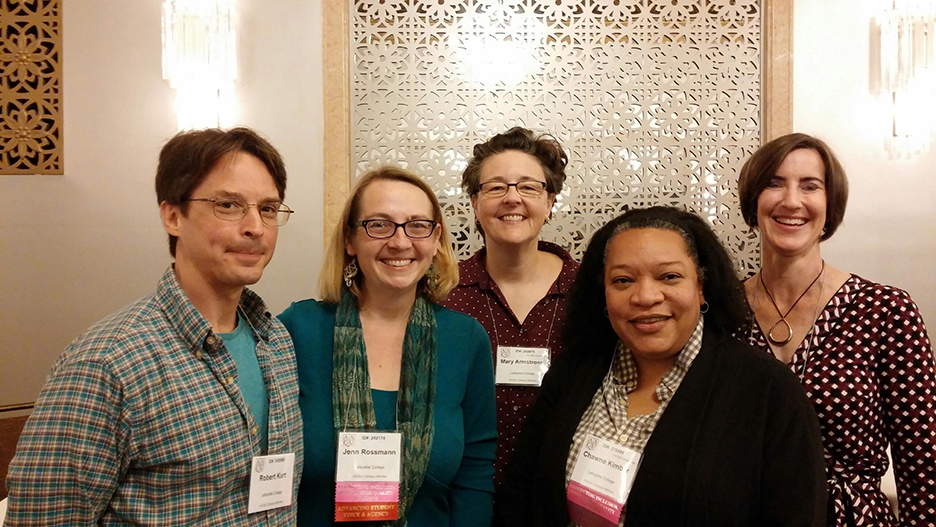
From left, Bob Kurt (biology), Jenn Stroud Rossmann (mechanical engineering), Mary Armstrong (women’s and gender studies), Chawne Kimber (math), and Kristen Sanford Bernhardt (civil & environmental engineering and environmental studies)
By Katie Neitz
How do you make a great thing greater? Make it more inclusive.
Stats from the National Science Foundation show a dramatic disparity between the demographics of the U.S. population and those who work in STEM (science, technology, engineering, and mathematics) fields. More than 80 percent of scientists and engineers in the United States are white or Asian American; only 6 percent are Hispanic, and only 5 percent are African American. And while women have gained some ground over the past 20 years, they still are severely underrepresented in STEM industries.
Interest in addressing these disparities isn’t new. There have been ongoing efforts to extend the reach of STEM-related fields across campus for years. But the way it’s being approached is different now.
In the past, innovative programs and courses designed or redesigned with inclusivity in mind were often orchestrated by individual champions, whose work was typically confined to their own classrooms and done on their own volition. Now, those individuals are starting to join forces to drive change and intentionally embed inclusive STEM into campus culture.
While faculty across the College are involved in this work, an interdisciplinary group of six of them are leading the charge as part of the College’s Inclusive STEM initiative. The goal is to shift the demographics in STEM and broaden the conversation regarding the need for more inclusive climates in STEM-related fields.
Jenn Stroud Rossmann, professor of mechanical engineering, and Mary Armstrong, Charles A. Dana Professor and chair of women’s and gender studies, are co-leaders of the initiative, whose members also include Bob Kurt, Gideon R. Kreider Jr. and Alice L. Kreider Professor and head of biology, Chawne Kimber, professor and associate head of mathematics, Mary Roth, professor and head of civil and environmental engineering, and Kristen Sanford Bernhardt, associate professor of civil and environmental engineering and chair of Lafayette’s engineering studies program.
“There have been related programs and academic curricula that have already been successful at Lafayette,” Armstrong says. “We want to foster conversations across separate pockets of interests and help connect them. We also want to help make STEM more inclusive to ensure that underrepresented groups are participating and thriving. This work is an emblem of the cooperative, interdisciplinary relationships that most of us come to a college like this to have. We know that this will benefit students in a way we can only dream about.”
While the initiative is spearheaded by this core group, there are dozens of other faculty members from diverse disciplinary backgrounds who have expressed interest and want to help advance the cause.
“People from all different departments, from the natural and social sciences to the humanities, are interested in collaborating to make academic cultures more inclusive, to understand and contextualize STEM knowledge and culture, and to foster success in students from different backgrounds,” Rossmann says. “Everyone wants to learn from each other. Very organically, this initiative has become so integrated.”
In order to gain more knowledge and provide more guidance on campus efforts, five members of the initiative attended the Association of American Colleges and Universities’ conference on “transforming STEM in higher education” in San Francisco Nov. 2-4. While individual faculty members have gone to this conference in the past, this was the first time a group attended with the explicit mission of bringing back ideas, strategies, and knowledge that can be shared and acted upon.
“We want to learn how to build our own capacity and gain information about best practices that have worked elsewhere, but also, we want to think at a larger scale,” Rossmann says. “We have expertise locally. We know how to teach these classes. We know how to do this research. But we want to work together to learn how we can make it more systemic and a well-structured part of the mainstream institution. How do we make these efforts coordinated, and built into the institution, and sustainable?”
Armstrong, Rossmann, and their colleagues recognize they are just beginning their journey and are excited to continue the conversation with the many colleagues on campus who are also interested in these issues. The information they gathered at the AACU conference will help concerned faculty work together to formulate a successful roadmap for the future of inclusive STEM at Lafayette.
“We understand that outcomes in STEM are better through inclusive excellence, and institutions of higher education are better when they are more inclusive,” Armstrong says. “And so inclusive STEM seems to be at the heart of an institution like Lafayette, where we hope to fully integrate the liberal arts and engineering, and it’s already understood that inclusive excellence improves everything we do.”
